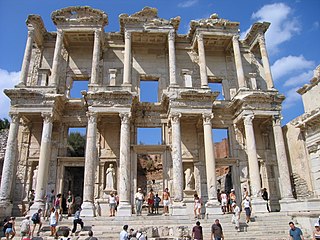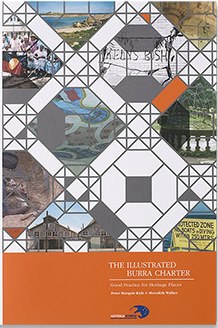Related Research Articles
The International Council on Monuments and Sites is a professional association that works for the conservation and protection of cultural heritage places around the world. Now headquartered in Charenton-le-Pont, France, ICOMOS was founded in 1965 in Warsaw as a result of the Venice Charter of 1964 and offers advice to UNESCO on World Heritage Sites.

Historic preservation (US), built heritage preservation or built heritage conservation (UK) is an endeavor that seeks to preserve, conserve and protect buildings, objects, landscapes or other artifacts of historical significance. It is a philosophical concept that became popular in the twentieth century, which maintains that cities as products of centuries' development should be obligated to protect their patrimonial legacy. The term refers specifically to the preservation of the built environment, and not to preservation of, for example, primeval forests or wilderness.

Conservation and restoration of immovable cultural property describes the process through which the material, historical, and design integrity of any immovable cultural property are prolonged through carefully planned interventions. The individual engaged in this pursuit is known as an architectural conservator-restorer. Decisions of when and how to engage in an intervention are critical to the ultimate conservation-restoration of cultural heritage. Ultimately, the decision is value based: a combination of artistic, contextual, and informational values is normally considered. In some cases, a decision to not intervene may be the most appropriate choice.

Anastylosis is an architectural conservation term for a reconstruction technique whereby a ruined building or monument is restored using the original architectural elements to the greatest degree possible, combined with modern materials if necessary, ensuring that the latter are unobtrusive while clearly recognizable as replacement materials. It is also sometimes used to refer to a similar technique for restoring broken pottery and other small objects.

The International Committee for the Conservation of the Industrial Heritage, usually known by its acronym TICCIH, is the international society dedicated to the study of industrial archaeology and the protection, promotion and interpretation of the industrial heritage. TICCIH's Nizhny Tagil Charter (archived), signed in 2003, is the international guidance document for the industrial heritage. In 2011, the Joint ICOMOS – TICCIH Principles for the Conservation of Industrial Heritage Sites, Structures, Areas and Landscapes, also called "The Dublin Principles", were adopted in Paris.

The Burra Charter is a document published by the Australian ICOMOS which defines the basic principles and procedures to be followed in the conservation of Australian heritage places. The Charter was first endorsed in 1979 as an Australian adaptation of the Venice Charter, but with the introduction of a new analytical conservation model of heritage assessment that recognised forms of cultural heritage beyond tangible and physical forms. The Charter was the first national heritage document to replace the Venice Charter as the basis of national heritage practice. The Charter has been revised on four occasions since 1979, and has been internationally influential in providing standard guidelines for heritage conservation practice.
Australia ICOMOS is a peak cultural heritage conservation body in Australia. It is a branch of the United Nations-sponsored International Council on Monuments and Sites (ICOMOS), a non-government professional organisation promoting expertise in the conservation of place-based cultural heritage. Its secretariat is based at the Cultural Heritage Centre for Asia and the Pacific at Deakin University.

Facadism, façadism, or façadomy is the architectural and construction practice where the facade of a building is designed or constructed separately from the rest of a building, or when only the facade of a building is preserved with new buildings erected behind or around it.

The World Heritage Convention, formally the Convention Concerning the Protection of the World Cultural and Natural Heritage, is an international treaty signed on 23 November 1972, which created the World Heritage Sites, with the primary goals of nature conservation and the preservation of cultural properties. The convention, a signed document of international agreement, guides the work of the World Heritage Committee. It was developed over a seven-year period (1965–1972).

Reconstruction in architectural conservation is the returning of a place to a known earlier state by the introduction of new materials. It is related to the architectural concepts of restoration and preservation, wherein the most extensive form of reconstruction is creating a replica of a destroyed building.
The Barcelona Charter, in full the European Charter for the Conservation and Restoration of Traditional Ships in Operation is an informal but widely accepted standard for maintenance and restoration projects on historic watercraft that are still in operation as active sailing vessels.
Archaeology Under the Canopy is a conservation strategy developed by Dr. Anabel Ford for the preservation of pre-Columbian Maya monuments at the archeological site El Pilar, an ancient Maya center on the border of Belize and Guatemala. This style of conservation encourages the conservation of Maya forest foliage for the protection of monuments and the strategic exposure of ancient structures.
The Athens Charter for the Restoration of Historic Monuments is a seven-point manifesto adopted at the First International Congress of Architects and Technicians of Historic Monuments in Athens in 1931.

The values embodied in cultural heritage are identified in order to assess significance, prioritize resources, and inform conservative-restorative decision-making. It is recognised that values may compete and change over time, and that heritage may have different meanings for different stakeholders.
The Principles for the Conservation of Heritage Sites in China is a conservation charter promulgated in 2000 by China ICOMOS with the approval of National Cultural Heritage Administration. It provides a methodological approach to the conservation of cultural heritage sites in China.
The Convention for the Protection of the Architectural Heritage of Europe is a legally binding instrument which set the framework for an accurate conservation approach within Europe. For a total of forty three member states of the Council of Europe, the convention's total ratification/accession has reached forty-two countries since it was opened for signature in 1985. It entered into force on 1 December 1987.
The Nara Document on Authenticity is a document that addresses the need for a broader understanding of cultural diversity and cultural heritage in relation to conservation in order to evaluate the value and authenticity of cultural property more objectively. It was drafted by 45 representatives from 28 countries after their deliberation on the definition and assessment of authenticity during the Nara Conference held in Nara in November 1994.
Raymond Martin Marie Ghislain, Baron Lemaire was an art historian and an architectural historian, a leading expert in conservation and professor at the Catholic University of Leuven and later at the KU Leuven and the Université catholique de Louvain in Louvain-la-Neuve.
The Institute of Historic Building Conservation (IHBC) is a professional body in the United Kingdom which was formed as a charitable trust company in 1997 by members of the former Association of Conservation Officers. The object was to widen the scope of the profession from those mainly concerned with the statutory regulation of the historic environment to all those who practice professionally in historic and built environment conservation.
The Classification of Built Heritage in Portugal corresponds to a group or independent Portuguese archeological civic, military and religious cultural properties deemed to be of sufficient historical value by the Direção-Geral do Património Cultural for protection and conservation. The precise rules for the classification and protection of cultural properties are defined in a heritage registry, that includes inventories of the natural and man-made, tangible and intangible, movable and immovable properties of a cultural, esthetic, social, technical and scientific nature.
References
- 1 2 3 4 "Erdem, C. The Venice Charter under Review. (1977). Ankara" (PDF). March 1977. Retrieved 2012-07-06.
- ↑ Cameron, ChristinaReconstruction: changing attitudes, UNESCO
- 1 2 3 4 5 "ICOMOS. (2004). The History of the Venice Charter" (PDF). Retrieved 2012-06-02.
- ↑ "The Athens Charter for the Restoration of Historic Monuments. (1931). Athens". Archived from the original (Web page) on 2012-10-25. Retrieved 2012-07-05.
- ↑ "The GETTY Conservation Institute. Cultural Heritage Policy Documents: General Conclusions of the Athens Conference 1931" (Web page). Retrieved 2012-07-05.
- ↑ "IInd International Congress of Architects and Technicians of Historic Monuments Committee. (1964). Decisions and Resolutions. Venice" (PDF). 1964-03-31. Retrieved 2012-06-01.
- 1 2 3 4 Hardy, Matthew (Ed.) The Venice Charter Revisited: Modernism, Conservation and Tradition in the 21st Century, foreword by HRH The Prince of Wales, Cambridge Scholars Publishing, Newcastle upon Tyne, UK; 2008
- ↑ "Convention Concerning the Protection of the World Cultural and Natural Heritage. (1972)" (Web Page). Retrieved 2012-07-06.
- 1 2 "Petzet, M. .(2004). Principles of Preservation: An introduction to the International Charters for Conservation and Restoration 40 years after the Venice Charter" (Web Page). Retrieved 2012-06-05.
- 1 2 ICOMOS Scientific Journal: Raymond Lemaire: ICOMOS - un regard en arrière, un coup d'oeil en avant. (1995). Paris. (PDF), 1995-11-07, retrieved 2012-06-01